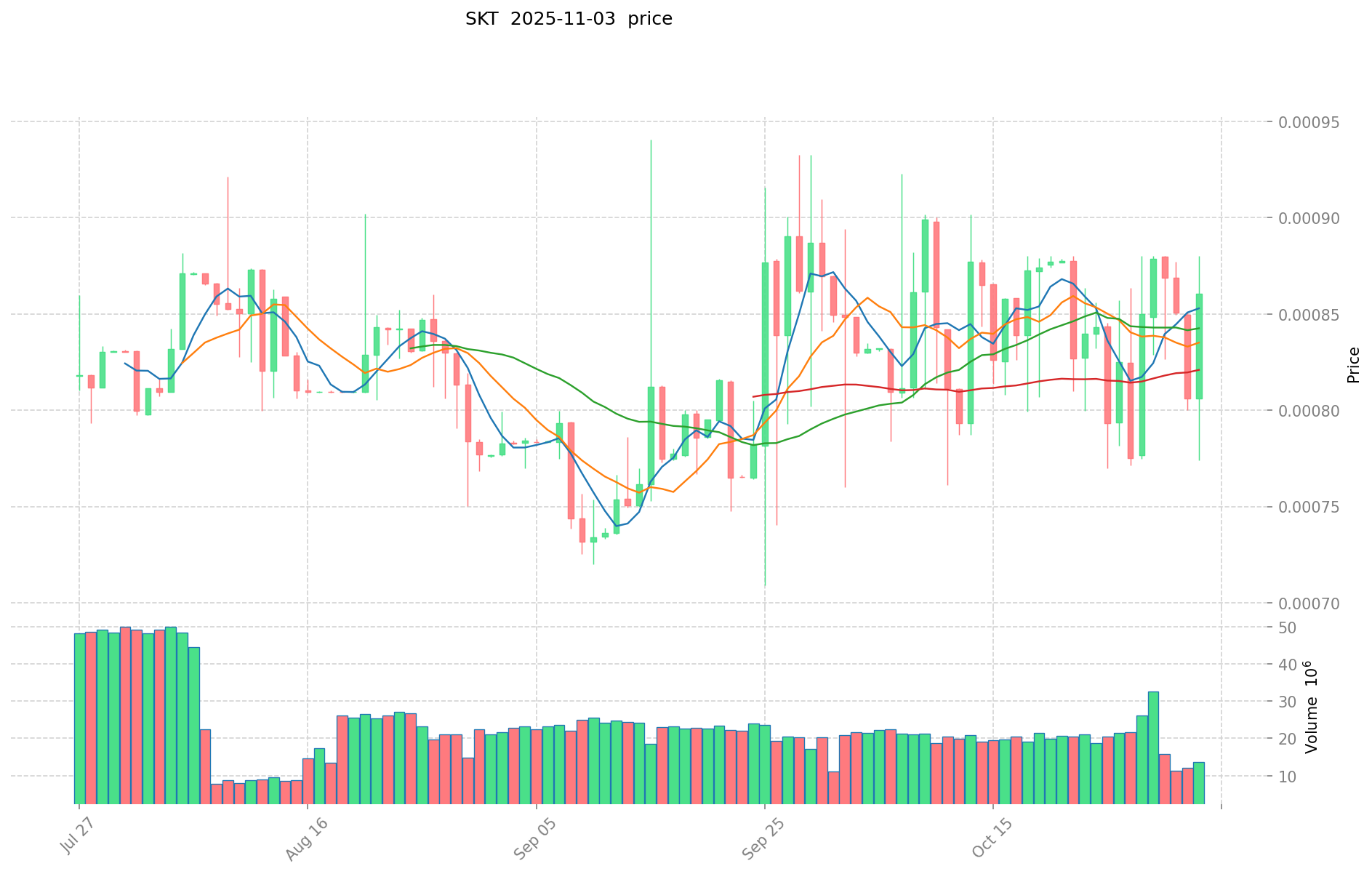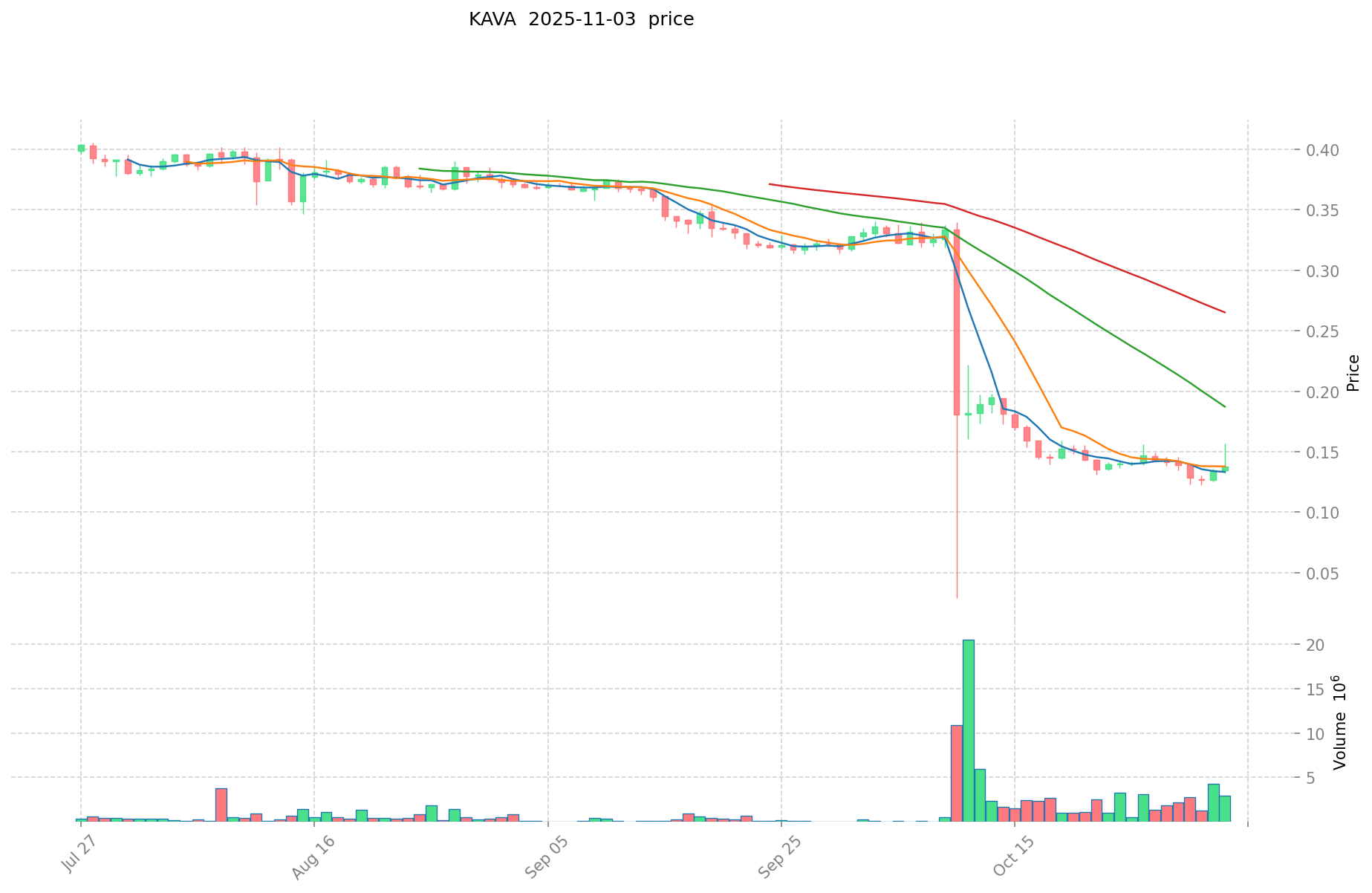SKT vs KAVA: A Battle of Titans in the League of Legends World Championship
Introduction: Investment Comparison of SKT vs KAVA
In the cryptocurrency market, the comparison between Sukhavati Network (SKT) vs Kava (KAVA) has been an unavoidable topic for investors. The two not only show significant differences in market cap ranking, application scenarios, and price performance, but also represent different positions in the crypto asset landscape.
Sukhavati Network (SKT): Since its launch in 2021, it has gained market recognition for its focus on decentralized cloud storage services.
Kava (KAVA): Introduced in 2019, it has been hailed as a cross-chain DeFi platform, becoming one of the notable projects in the decentralized finance space.
This article will provide a comprehensive analysis of the investment value comparison between SKT and KAVA, focusing on historical price trends, supply mechanisms, institutional adoption, technological ecosystems, and future predictions, attempting to answer the question investors care about most:
"Which is the better buy right now?" I. Price History Comparison and Current Market Status
SKT and KAVA Historical Price Trends
- 2021: KAVA reached its all-time high of $9.12 in August due to increased adoption and market enthusiasm.
- 2025: SKT hit its all-time low of $0.00070611 in April, possibly due to market-wide bearish sentiment.
- Comparative analysis: During the recent market cycle, KAVA dropped from its peak of $9.12 to current levels around $0.11, while SKT has remained relatively stable at low price levels.
Current Market Situation (2025-11-04)
- SKT current price: $0.0008418
- KAVA current price: $0.11794
- 24-hour trading volume: SKT $9,643.51 vs KAVA $556,327.10
- Market Sentiment Index (Fear & Greed Index): 42 (Fear)
Click to view real-time prices:
- View SKT current price Market Price
- View KAVA current price Market Price


II. Core Factors Affecting SKT vs KAVA Investment Value
Supply Mechanism Comparison (Tokenomics)
- SKT: More revenue-oriented with weaker stablecoin properties
- KAVA: Functions primarily as a yield-generating project with limited stablecoin attributes
- 📌 Historical Pattern: After Luna's collapse, yield-focused projects like these have shifted toward long-term sustainable revenue models to subsidize users
Institutional Adoption and Market Applications
- Institutional Holdings: Both tokens appear to have limited institutional presence as primary investment assets
- Enterprise Adoption: Both tokens function more as yield-generating mediums rather than widely circulated payment or settlement tools
- Regulatory Attitudes: Currently unclear specific regulatory positions toward these tokens
Technical Development and Ecosystem Building
- Market Circulation: Neither token appears to be widely used as trading pairs or value storage in mainstream markets
- Use Case: Both primarily serve as mediums for generating yields rather than true stablecoins
- Ecosystem Comparison: Current implementations seem focused on yield mechanisms rather than broader DeFi utility
Macroeconomic and Market Cycles
- Post-Luna Crash Environment: These projects represent the trend toward sustainable yield models following market corrections
- Revenue Sources: Some similar projects use US Treasury bonds as foundational revenue sources
- Market Perception: These tokens are increasingly categorized as yield projects rather than stablecoins, affecting their market positioning
III. 2025-2030 Price Prediction: SKT vs KAVA
Short-term Prediction (2025)
- SKT: Conservative $0.000444776 - $0.0008392 | Optimistic $0.0008392 - $0.001107744
- KAVA: Conservative $0.0641196 - $0.11874 | Optimistic $0.11874 - $0.1389258
Mid-term Prediction (2027)
- SKT may enter a growth phase, with an estimated price range of $0.001063761528 - $0.001532731664
- KAVA may enter a steady growth phase, with an estimated price range of $0.0941768499 - $0.1994333292
- Key drivers: Institutional capital inflow, ETF, ecosystem development
Long-term Prediction (2030)
- SKT: Base scenario $0.001743679292448 - $0.002040104772164 | Optimistic scenario $0.002040104772164
- KAVA: Base scenario $0.222944233539116 - $0.271991964917721 | Optimistic scenario $0.271991964917721
Disclaimer: The above predictions are based on historical data and market analysis. Cryptocurrency markets are highly volatile and subject to rapid changes. These projections should not be considered as financial advice. Always conduct your own research before making investment decisions.
SKT:
| 年份 | 预测最高价 | 预测平均价格 | 预测最低价 | 涨跌幅 |
|---|---|---|---|---|
| 2025 | 0.001107744 | 0.0008392 | 0.000444776 | 0 |
| 2026 | 0.0013141872 | 0.000973472 | 0.00094426784 | 15 |
| 2027 | 0.001532731664 | 0.0011438296 | 0.001063761528 | 35 |
| 2028 | 0.00196727252904 | 0.001338280632 | 0.00089664802344 | 58 |
| 2029 | 0.001834582004377 | 0.00165277658052 | 0.001355276796026 | 96 |
| 2030 | 0.002040104772164 | 0.001743679292448 | 0.001360069848109 | 107 |
KAVA:
| 年份 | 预测最高价 | 预测平均价格 | 预测最低价 | 涨跌幅 |
|---|---|---|---|---|
| 2025 | 0.1389258 | 0.11874 | 0.0641196 | 0 |
| 2026 | 0.148157835 | 0.1288329 | 0.068281437 | 9 |
| 2027 | 0.1994333292 | 0.1384953675 | 0.0941768499 | 17 |
| 2028 | 0.2382397311735 | 0.16896434835 | 0.1503782700315 | 43 |
| 2029 | 0.242286427316482 | 0.20360203976175 | 0.118089183061815 | 72 |
| 2030 | 0.271991964917721 | 0.222944233539116 | 0.138225424794252 | 89 |
IV. Investment Strategy Comparison: SKT vs KAVA
Long-term vs Short-term Investment Strategy
- SKT: Suitable for investors focused on decentralized cloud storage potential
- KAVA: Suitable for investors interested in cross-chain DeFi platforms
Risk Management and Asset Allocation
- Conservative investors: SKT: 30% vs KAVA: 70%
- Aggressive investors: SKT: 60% vs KAVA: 40%
- Hedging tools: Stablecoin allocation, options, cross-currency combinations
V. Potential Risk Comparison
Market Risk
- SKT: Limited market recognition and adoption
- KAVA: Volatility in the DeFi sector
Technical Risk
- SKT: Scalability, network stability
- KAVA: Smart contract vulnerabilities, cross-chain security issues
Regulatory Risk
- Global regulatory policies may impact both tokens differently, with DeFi platforms potentially facing more scrutiny
VI. Conclusion: Which Is the Better Buy?
📌 Investment Value Summary:
- SKT advantages: Focus on decentralized cloud storage, potential for growth in the emerging sector
- KAVA advantages: Established presence in the DeFi space, cross-chain functionality
✅ Investment Advice:
- New investors: Consider a balanced approach, with a slight preference for KAVA due to its more established market presence
- Experienced investors: Explore a diversified portfolio including both tokens, with allocation based on risk tolerance
- Institutional investors: Conduct thorough due diligence on both projects, considering KAVA for its DeFi ecosystem and SKT for its potential in decentralized storage solutions
⚠️ Risk Warning: The cryptocurrency market is highly volatile, and this article does not constitute investment advice. None
VII. FAQ
Q1: What are the main differences between SKT and KAVA? A: SKT focuses on decentralized cloud storage services, while KAVA is a cross-chain DeFi platform. SKT is newer (launched in 2021) compared to KAVA (introduced in 2019). KAVA has a higher market cap and trading volume, but both tokens are primarily used for yield generation rather than as stablecoins.
Q2: Which token has performed better historically? A: KAVA has shown more significant price movements, reaching an all-time high of $9.12 in August 2021. However, it has since experienced a substantial drop to current levels around $0.11. SKT, on the other hand, has remained relatively stable at lower price levels, with its all-time low of $0.00070611 in April 2025.
Q3: What are the key factors affecting the investment value of SKT and KAVA? A: Key factors include their supply mechanisms (tokenomics), institutional adoption, market applications, technical development, ecosystem building, and macroeconomic conditions. Both tokens are now viewed more as yield-generating projects rather than stablecoins, which affects their market positioning and potential growth.
Q4: How do the future price predictions compare for SKT and KAVA? A: By 2030, SKT's base scenario price range is predicted to be $0.001743679292448 - $0.002040104772164, while KAVA's is $0.222944233539116 - $0.271991964917721. KAVA is expected to show higher growth potential in terms of absolute price, but investors should consider the relative growth potential from current price levels for both tokens.
Q5: What are the main risks associated with investing in SKT and KAVA? A: Both tokens face market risks, technical risks, and regulatory risks. SKT's main risks include limited market recognition and potential scalability issues. KAVA faces risks related to DeFi sector volatility, smart contract vulnerabilities, and cross-chain security challenges. Regulatory risks could impact both tokens, with DeFi platforms potentially facing more scrutiny.
Q6: How should different types of investors approach SKT and KAVA? A: New investors might consider a balanced approach with a slight preference for KAVA due to its more established market presence. Experienced investors could explore a diversified portfolio including both tokens, based on their risk tolerance. Institutional investors should conduct thorough due diligence, considering KAVA for its DeFi ecosystem and SKT for its potential in decentralized storage solutions.
Q7: Are SKT and KAVA suitable for long-term or short-term investment strategies? A: Both tokens can be considered for long-term and short-term strategies, depending on the investor's goals. SKT might be more suitable for those interested in the long-term potential of decentralized cloud storage, while KAVA could appeal to investors looking at both short-term DeFi opportunities and long-term cross-chain platform growth.
Share
Content